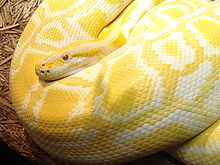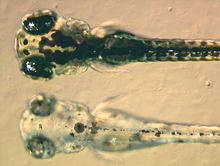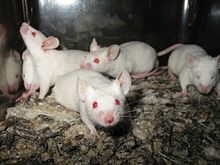Amelanism: Difference between revisions
No edit summary |
|||
| Line 1: | Line 1: | ||
[[File:Burmese Python 02.jpg|right|thumb|Often called "albino," this amelanistic python owes its yellow color to unaffected carotenoid pigments.]] |
|||
#redirect[[Albinism]] |
|||
'''Amelanism''' is a pigmentation abnormality characterized by the lack of [[Biological pigment|pigments]] called [[melanin]]s, commonly associated with a [[Genetics|genetic]] loss of [[tyrosinase]] function. Amelanism can affect [[fishes]], [[amphibian]]s, [[reptile]]s, [[bird]]s, and [[mammal]]s including humans. The appearance of an amelanistic animal depends on the remaining non-melanin pigments. |
|||
==Melanins and melanin production== |
|||
[[Melanin]] is a compound found in [[plant]]s, [[animal]]s, and [[protist]]s, and is derived from the [[amino acid]] [[tyrosine]]. Melanin is a [[photoprotection|photoprotectant]], absorbing the [[Direct DNA damage|DNA-damaging]] [[ultraviolet]] radiation of the sun. [[Vertebrate]]s have melanin in their [[skin]] and [[hair]], [[feather]]s, or [[Scale (zoology)|scales]]. They also have two layers of pigmented tissue in the eye: the [[stroma]], at the front of the [[Iris (anatomy)|iris]], and the [[iris pigment epithelium]], a thin but critical layer of pigmented cells at the back of the iris. Melanin is also present in the [[inner ear]], and is important for the early development of the [[auditory]] system.<ref name=robins1991>{{cite book |title=Biological perspectives on human pigmentation |pages=76-77 |first=Ashley H. |last=Robins |edition=1 |publisher=Cambridge University Press |year=1991 |isbn=0521365147}}</ref> Melanin is also found in parts of the [[brain]] and [[adrenal gland]]. |
|||
[[File:Zebrafish embryos.png|thumb|right|The normal zebrafish embryo, above, shows the migration and maturation of melanocytes. The amelanistic embryo, below, has melanocytes but no melanin.]] |
|||
Melanins are produced in [[organelle]]s called [[melanosome]]s. The production of melanins is called [[melanogenesis]]. Melanosomes are found in specialized pigment cells called [[melanocyte]]s, but may also be engulfed by other cells, which are then called melanophages. A critical step in the production of melanins is the [[catalysis]] of [[tyrosine]] by an [[enzyme]] called [[tyrosinase]], producing dopaquinone. Dopaquinone may become eumelanin, or phaeomelanin. Eumelanin, meaning ''true black'', is a dense [[Chemical compound|compound]] which absorbs most wavelengths of light, and appears black or brown as a result. Phaeomelanin, meaning ''rufous-black'', is characterized by the presence of [[sulfur]]-containing [[cysteine]], and it appears reddish to yellowish as a result. Melanosomes containing eumelanin are eumelanosomes, while those containing phaeomelanin are phaeomelanosomes. A hormone called [[Melanocortin 1 receptor]] (MC1R) commits melanocytes to the production of eumelanin. Another chemical, [[Agouti signalling peptide]], can attach itself to MC1R and interfere with this signalling. In the absence of MC1R, melanocytes produce phaeomelanin. Hair acquires pigment from melanocytes in the root bulb, which deposit melanosomes into the growing hair structure. |
|||
[[File:Lightmatter lab mice.jpg|thumb|left|Amelanistic laboratory mice, such as these, have no pigment in their skin, hair, or eyes. Their eyes are reddish.]] |
|||
Melanocytes, and the parallel [[Chromatophore|melanophore]]s found in fishes, amphibians, and reptiles, are derived from a strip of tissue in the [[embryo]] called the [[neural crest]]. [[Stem cell]]s in the neural crest give rise to the cells of the [[autonomic nervous system]], supportive elements of the skeleton such as [[chondrocyte]]s, cells of the [[endocrine system]], and melanocytes. This strip of tissue is found along the dorsal midline of the [[embryo]], and [[multipotent]] cells migrate down along the sides of the embryo, or through [[germ layer]]s, to their ultimate destinations. Melanocyte stem cells are called melanoblasts. Conditions associated with abnormalities in the migration of melanoblasts are known collectively as [[piebaldism]]. Pigment cells of the [[iris pigment epithelium]] have a separate embryological origin.<ref name=robins-2>Robins, Ashley H. (1991) pg. 75</ref> Piebaldism and amelanism are distinct conditions. |
|||
==Amelanism in mammals== |
|||
The only pigments that mammals produce are melanins. For a mammal to be unable to chemically manufacture melanin renders it completely pigmentless. This condition is more commonly called [[albinism]]. Amelanistic mammals have white hair, pink skin, and pink or reddish eyes. Reddish eyes are due to the lack of pigment in the [[iris pigment epithelium]]. When the [[stroma]] is unpigmented but the iris pigment epithelium is not, mammalian eyes appear blue. Melanin in the pigment epithelium is critical for visual acuity and contrast.<ref name=retina>{{cite book |title=Text Atlas of the Retina |chapter=16 Retinal pigment epitheliopathies |coauthors=Arun D. Singh & Harminder S. Dua |pages=249 |editor=A. M. Peter Hamilton, Richard Gregson, Gary Edd Fish |edition=1 |publisher=Informa Health Care |year=1997 |isbn=185317226X}}</ref> |
|||
Loss of melanogenesis function is linked to the [[gene]] that encodes [[tyrosinase]]. Certain [[allele]]s of this gene, ''TYR'', at the ''Color'' locus, cause [[Oculocutaneous albinism|oculocutaneous albinism type 1]] in humans and the familiar red-eyed albino conditions in [[mice]] and other mammals. |
|||
[[File:Nymphicus hollandicus2.jpg|thumb|right|Amelanistic ("Lutino") cockatiels retain their carotenoid-based red and yellow pigments.]] |
|||
==Amelanism in other vertebrates== |
|||
Other vertebrates, such as fishes, amphibians, reptiles and birds, produce a variety of non-melanin [[Biological pigment|pigments]]. Disruption of melanin production does not affect the production of these pigments. Non-melanin pigments in other vertebrates are produced by cells called [[chromatophore]]s. Within this categorization, xanthophores are cells which contain primarily yellowish pteridines, while erythrophores are those which contain primarily orangish [[carotenoid]]s. Some species also possess iridophores or leucophores, which do not contain true pigments, but light-reflective structures that give iridescence. An extremely uncommon type of chromatophore, the cyanophore, produces a very vivid blue pigment.<ref name=cyanophore>Fujii R. The regulation of motile activity in fish chromatophores. ''Pigment Cell Res''. 2000; 13:300-19. PMID 11041206</ref> Amelanism in fishes, amphibians, reptiles and birds has the same [[genetic]] [[etiology]] as in mammals: loss of [[tyrosinase]] function. However, due to the presence of other pigments, other amelanistic vertebrates are seldom white and red-eyed like amelanistic mammals. |
|||
[[File:Afra 007.jpg|thumb|right|Without melanocortin 1 receptor to signal euemlanin production in melanocytes, this Labrador retriever has a yellow coat. His eyes and skin are normal.]] |
|||
==Aeumelanism== |
|||
Melanocytes depend on the hormone [[Melanocortin 1 receptor]] (MC1R) to signal the production of eumelanin. Loss of melanocortin 1 receptor function or high activity of the MC1R-antagonist, [[Agouti signalling peptide]], can cause the widespread absence of eumelanin. Loss of MC1R function, a recessive trait, has been observed in many species. In humans, various [[mutation]]s of the ''MC1r'' gene result in [[red hair]], [[blond hair]], fair skin, and susceptibility to sundamaged skin and [[melanoma]].<ref name=OMIMMC1R>Online Mendelian Inheritance in Man, OMIM (TM). Johns Hopkins University, Baltimore, MD. MIM Number: {155555}: {5/15/2009}:. World Wide Web URL: http://www.ncbi.nlm.nih.gov/omim/</ref> Aeumelanic hair coats, associated with mutations of the ''MC1R'' gene, have also been identified in mice,<ref name=robbins1993>{{cite journal |last=Robbins |first=L.S. |coauthors=Nadeau, J. H.; Johnson, K. R.; Kelly, M. A.; Roselli-Rehfuss, L.; Baack, E.; Mountjoy, K. G.; Cone, R. D. |title=Pigmentation phenotypes of variant extension locus alleles result from point mutations that alter MSH receptor function |journal=Cell |volume=72 |pages=827-834 |year=1993 |pmid=8458079}}</ref> cattle,<ref name=joerg1996>{{cite journal |last=Joerg |first=H |coauthors=Fries, H. R.; Meijerink, E.; Stranzinger, G. F. |title=Red coat color in Holstein cattle is associated with a deletion in the MSHR gene |journal=Mammalian Genome |volume=7 |pages=317-318 |year=1996 |pmid=8661706 }}</ref> dogs,<ref name=newton2000>{{cite journal |last=Newton |first=JM |coauthors=Wilkie, A. L.; He, L.; Jordan, S. A.; Metallinos, D. L.; Holmes, N. G.; Jackson, I. J.; Barsh, G. S. |title=Melanocortin 1 receptor variation in the domestic dog |journal=Mammalian Genome |volume=11 |pages=24-30 |year=2000 |pmid=10602988 }}</ref> and horses.<ref name=marklund1996>{{cite journal |last=Marklund |first=L |coauthors=Moller MJ, Sandberg K, Andersson L |title=A missense mutation in the gene for melanocyte-stimulating hormone receptor (MC1R) is associated with the chestnut coat color in horses |journal=Mammalian Genome |year=1996 |month=Dec |volume=7 |issue=12 |pages=895-9}}</ref> These coat colors are called "yellow" in mice and dogs, "red" in cattle and [[Chestnut (coat)|chestnut]] in horses. The loss of eumelanin in the coat is, in these species, harmless. The distinction between aeumelanism and hyperphaeomelanism - over abundance of phaeomelanin - is semantic. |
|||
[[File:Brown and black horse.JPG|thumb|left|The normal horse, left, has both eumelanin and phaeomelanin in her coat. The horse at right lacks the agouti signalling protein, and has a uniformly black or aphaeomelanistic coat. The eyes and skin are unaffected.]] |
|||
==Aphaeomelanism== |
|||
Aphaeomelanism is the abnormal absence of phaeomelanin from the [[integumentary system]] and/or eyes.<ref name=birding>{{cite journal |journal=Birding |volume=39 |issue=5 |month=September/October |year=2007 |title=Color Abnormalities |publisher=American Birding Association |last=Davis |first=Jeff N. |pages=36-46}}</ref> Phaeomelanin is produced by melanocytes in the absence of melanocortin 1 receptor. This absence is mediated by agouti signalling protein, which antagonizes melanocortin 1 receptor. Loss of function of agouti signalling protein can permit unmediated phaeomelanin production, producing a uniformly black-to-brown coat color. This condition can be observed in dogs,<ref name=kerns>{{cite journal |first=Julie A. |last=Kerns |coauthors=J. Newton, Tom G. Berryere, Edward M. Rubin, Jan-Fang Cheng, Sheila M. Schmutz and Gregory S. Barsh |title=Characterization of the dog Agouti gene and a nonagouti mutation in German Shepherd Dogs |journal=Mammalian Genome |publisher=Springer New York |issn=1432-1777 |volume=15 |issue=10 |month=October |year=2004 |doi=10.1007/s00335-004-2377-1 |pages=798-808}}</ref> cats,<ref name=OMIM-ASIP>[http://www.ncbi.nlm.nih.gov/entrez/dispomim.cgi?id=600201] Online Mendelian Inheritance in Man, OMIM (TM). Johns Hopkins University, Baltimore, MD. MIM Number: {600201}: {9/4/2008}:. World Wide Web URL: http://www.ncbi.nlm.nih.gov/omim/</ref> and horses.<ref name=rieder2001>{{cite journal |last=Rieder |first=Stefan |coauthors=Sead Taourit, Denis Mariat, Bertrand Langlois, Ge´rard Gue´rin |title=Mutations in the agouti (ASIP), the extension (MC1R), and the brown (TYRP1) loci and their association to coat color phenotypes in horses (Equus caballus) |journal=Mammalian Genome |volume=12 |pages=450-455 |year=2001 |doi=10.1007/s003350020017 |publisher=Springer-Verlag}}</ref> The appearance of mammals with recessive agouti mutations is typically dense black. As with aeumelanism, the difference between lack of phaeomelanin and abundance of eumelanin is one of words. Some agouti alleles in mice are associated with health defects, but this is not the case in dogs, cats, or horses. |
|||
==References== |
|||
{{reflist}} |
|||
Revision as of 16:50, 23 July 2009

Amelanism is a pigmentation abnormality characterized by the lack of pigments called melanins, commonly associated with a genetic loss of tyrosinase function. Amelanism can affect fishes, amphibians, reptiles, birds, and mammals including humans. The appearance of an amelanistic animal depends on the remaining non-melanin pigments.
Melanins and melanin production
Melanin is a compound found in plants, animals, and protists, and is derived from the amino acid tyrosine. Melanin is a photoprotectant, absorbing the DNA-damaging ultraviolet radiation of the sun. Vertebrates have melanin in their skin and hair, feathers, or scales. They also have two layers of pigmented tissue in the eye: the stroma, at the front of the iris, and the iris pigment epithelium, a thin but critical layer of pigmented cells at the back of the iris. Melanin is also present in the inner ear, and is important for the early development of the auditory system.[1] Melanin is also found in parts of the brain and adrenal gland.

Melanins are produced in organelles called melanosomes. The production of melanins is called melanogenesis. Melanosomes are found in specialized pigment cells called melanocytes, but may also be engulfed by other cells, which are then called melanophages. A critical step in the production of melanins is the catalysis of tyrosine by an enzyme called tyrosinase, producing dopaquinone. Dopaquinone may become eumelanin, or phaeomelanin. Eumelanin, meaning true black, is a dense compound which absorbs most wavelengths of light, and appears black or brown as a result. Phaeomelanin, meaning rufous-black, is characterized by the presence of sulfur-containing cysteine, and it appears reddish to yellowish as a result. Melanosomes containing eumelanin are eumelanosomes, while those containing phaeomelanin are phaeomelanosomes. A hormone called Melanocortin 1 receptor (MC1R) commits melanocytes to the production of eumelanin. Another chemical, Agouti signalling peptide, can attach itself to MC1R and interfere with this signalling. In the absence of MC1R, melanocytes produce phaeomelanin. Hair acquires pigment from melanocytes in the root bulb, which deposit melanosomes into the growing hair structure.

Melanocytes, and the parallel melanophores found in fishes, amphibians, and reptiles, are derived from a strip of tissue in the embryo called the neural crest. Stem cells in the neural crest give rise to the cells of the autonomic nervous system, supportive elements of the skeleton such as chondrocytes, cells of the endocrine system, and melanocytes. This strip of tissue is found along the dorsal midline of the embryo, and multipotent cells migrate down along the sides of the embryo, or through germ layers, to their ultimate destinations. Melanocyte stem cells are called melanoblasts. Conditions associated with abnormalities in the migration of melanoblasts are known collectively as piebaldism. Pigment cells of the iris pigment epithelium have a separate embryological origin.[2] Piebaldism and amelanism are distinct conditions.
Amelanism in mammals
The only pigments that mammals produce are melanins. For a mammal to be unable to chemically manufacture melanin renders it completely pigmentless. This condition is more commonly called albinism. Amelanistic mammals have white hair, pink skin, and pink or reddish eyes. Reddish eyes are due to the lack of pigment in the iris pigment epithelium. When the stroma is unpigmented but the iris pigment epithelium is not, mammalian eyes appear blue. Melanin in the pigment epithelium is critical for visual acuity and contrast.[3]
Loss of melanogenesis function is linked to the gene that encodes tyrosinase. Certain alleles of this gene, TYR, at the Color locus, cause oculocutaneous albinism type 1 in humans and the familiar red-eyed albino conditions in mice and other mammals.

Amelanism in other vertebrates
Other vertebrates, such as fishes, amphibians, reptiles and birds, produce a variety of non-melanin pigments. Disruption of melanin production does not affect the production of these pigments. Non-melanin pigments in other vertebrates are produced by cells called chromatophores. Within this categorization, xanthophores are cells which contain primarily yellowish pteridines, while erythrophores are those which contain primarily orangish carotenoids. Some species also possess iridophores or leucophores, which do not contain true pigments, but light-reflective structures that give iridescence. An extremely uncommon type of chromatophore, the cyanophore, produces a very vivid blue pigment.[4] Amelanism in fishes, amphibians, reptiles and birds has the same genetic etiology as in mammals: loss of tyrosinase function. However, due to the presence of other pigments, other amelanistic vertebrates are seldom white and red-eyed like amelanistic mammals.

Aeumelanism
Melanocytes depend on the hormone Melanocortin 1 receptor (MC1R) to signal the production of eumelanin. Loss of melanocortin 1 receptor function or high activity of the MC1R-antagonist, Agouti signalling peptide, can cause the widespread absence of eumelanin. Loss of MC1R function, a recessive trait, has been observed in many species. In humans, various mutations of the MC1r gene result in red hair, blond hair, fair skin, and susceptibility to sundamaged skin and melanoma.[5] Aeumelanic hair coats, associated with mutations of the MC1R gene, have also been identified in mice,[6] cattle,[7] dogs,[8] and horses.[9] These coat colors are called "yellow" in mice and dogs, "red" in cattle and chestnut in horses. The loss of eumelanin in the coat is, in these species, harmless. The distinction between aeumelanism and hyperphaeomelanism - over abundance of phaeomelanin - is semantic.

Aphaeomelanism
Aphaeomelanism is the abnormal absence of phaeomelanin from the integumentary system and/or eyes.[10] Phaeomelanin is produced by melanocytes in the absence of melanocortin 1 receptor. This absence is mediated by agouti signalling protein, which antagonizes melanocortin 1 receptor. Loss of function of agouti signalling protein can permit unmediated phaeomelanin production, producing a uniformly black-to-brown coat color. This condition can be observed in dogs,[11] cats,[12] and horses.[13] The appearance of mammals with recessive agouti mutations is typically dense black. As with aeumelanism, the difference between lack of phaeomelanin and abundance of eumelanin is one of words. Some agouti alleles in mice are associated with health defects, but this is not the case in dogs, cats, or horses.
References
- ^ Robins, Ashley H. (1991). Biological perspectives on human pigmentation (1 ed.). Cambridge University Press. pp. 76–77. ISBN 0521365147.
- ^ Robins, Ashley H. (1991) pg. 75
- ^ A. M. Peter Hamilton, Richard Gregson, Gary Edd Fish, ed. (1997). "16 Retinal pigment epitheliopathies". Text Atlas of the Retina (1 ed.). Informa Health Care. p. 249. ISBN 185317226X.
{{cite book}}: Unknown parameter|coauthors=ignored (|author=suggested) (help)CS1 maint: multiple names: editors list (link) - ^ Fujii R. The regulation of motile activity in fish chromatophores. Pigment Cell Res. 2000; 13:300-19. PMID 11041206
- ^ Online Mendelian Inheritance in Man, OMIM (TM). Johns Hopkins University, Baltimore, MD. MIM Number: {155555}: {5/15/2009}:. World Wide Web URL: http://www.ncbi.nlm.nih.gov/omim/
- ^ Robbins, L.S. (1993). "Pigmentation phenotypes of variant extension locus alleles result from point mutations that alter MSH receptor function". Cell. 72: 827–834. PMID 8458079.
{{cite journal}}: Unknown parameter|coauthors=ignored (|author=suggested) (help) - ^ Joerg, H (1996). "Red coat color in Holstein cattle is associated with a deletion in the MSHR gene". Mammalian Genome. 7: 317–318. PMID 8661706.
{{cite journal}}: Unknown parameter|coauthors=ignored (|author=suggested) (help) - ^ Newton, JM (2000). "Melanocortin 1 receptor variation in the domestic dog". Mammalian Genome. 11: 24–30. PMID 10602988.
{{cite journal}}: Unknown parameter|coauthors=ignored (|author=suggested) (help) - ^ Marklund, L (1996). "A missense mutation in the gene for melanocyte-stimulating hormone receptor (MC1R) is associated with the chestnut coat color in horses". Mammalian Genome. 7 (12): 895–9.
{{cite journal}}: Unknown parameter|coauthors=ignored (|author=suggested) (help); Unknown parameter|month=ignored (help) - ^ Davis, Jeff N. (2007). "Color Abnormalities". Birding. 39 (5). American Birding Association: 36–46.
{{cite journal}}: Unknown parameter|month=ignored (help) - ^ Kerns, Julie A. (2004). "Characterization of the dog Agouti gene and a nonagouti mutation in German Shepherd Dogs". Mammalian Genome. 15 (10). Springer New York: 798–808. doi:10.1007/s00335-004-2377-1. ISSN 1432-1777.
{{cite journal}}: Unknown parameter|coauthors=ignored (|author=suggested) (help); Unknown parameter|month=ignored (help) - ^ [1] Online Mendelian Inheritance in Man, OMIM (TM). Johns Hopkins University, Baltimore, MD. MIM Number: {600201}: {9/4/2008}:. World Wide Web URL: http://www.ncbi.nlm.nih.gov/omim/
- ^ Rieder, Stefan (2001). "Mutations in the agouti (ASIP), the extension (MC1R), and the brown (TYRP1) loci and their association to coat color phenotypes in horses (Equus caballus)". Mammalian Genome. 12. Springer-Verlag: 450–455. doi:10.1007/s003350020017.
{{cite journal}}: Unknown parameter|coauthors=ignored (|author=suggested) (help)
